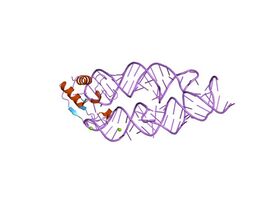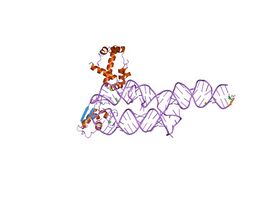Biology:Signal recognition particle
This article is missing information about overall structure (as context for "S domain" pics and for mechanism description); rough structure and function of binding proteins. (October 2021) |
| signal recognition particle 9kDa | |
|---|---|
| Identifiers | |
| Symbol | SRP9 |
| NCBI gene | 6726 |
| HGNC | 11304 |
| OMIM | 600707 |
| RefSeq | NM_003133 |
| UniProt | P49458 |
| Other data | |
| Locus | Chr. 1 q42.12 |
| signal recognition particle 14kDa | |
|---|---|
| Identifiers | |
| Symbol | SRP14 |
| NCBI gene | 6727 |
| HGNC | 11299 |
| OMIM | 600708 |
| RefSeq | NM_003134 |
| UniProt | P37108 |
| Other data | |
| Locus | Chr. 15 q22 |
| signal recognition particle 19kDa | |
|---|---|
| Identifiers | |
| Symbol | SRP19 |
| NCBI gene | 6728 |
| HGNC | 11300 |
| OMIM | 182175 |
| RefSeq | NM_003135 |
| UniProt | P09132 |
| Other data | |
| Locus | Chr. 5 q21-q22 |
| signal recognition particle 54kDa | |
|---|---|
| Identifiers | |
| Symbol | SRP54 |
| NCBI gene | 6729 |
| HGNC | 11301 |
| OMIM | 604857 |
| RefSeq | NM_003136 |
| UniProt | P61011 |
| Other data | |
| Locus | Chr. 14 q13.2 |
| signal recognition particle 68kDa | |
|---|---|
| Identifiers | |
| Symbol | SRP68 |
| NCBI gene | 6730 |
| HGNC | 11302 |
| OMIM | 604858 |
| RefSeq | NM_014230 |
| UniProt | Q9UHB9 |
| Other data | |
| Locus | Chr. 17 q25.1 |
| signal recognition particle 72kDa | |
|---|---|
| Identifiers | |
| Symbol | SRP72 |
| NCBI gene | 6731 |
| HGNC | 11303 |
| OMIM | 602122 |
| RefSeq | NM_006947 |
| UniProt | O76094 |
| Other data | |
| Locus | Chr. 4 q11 |
| Signal recognition particle protein | |||||||
|---|---|---|---|---|---|---|---|
| Identifiers | |||||||
| Organism | |||||||
| Symbol | ffh | ||||||
| Alt. symbols | p48, Srp54 | ||||||
| UniProt | P0AGD7 | ||||||
| |||||||
The signal recognition particle (SRP) is an abundant, cytosolic, universally conserved ribonucleoprotein (protein-RNA complex) that recognizes and targets specific proteins to the endoplasmic reticulum in eukaryotes and the plasma membrane in prokaryotes.[1]
History
The function of SRP was discovered by the study of processed and unprocessed secretory proteins, particularly immunoglobulin light chains;[2] and bovine preprolactin. Newly synthesized proteins in eukaryotes carry N-terminal hydrophobic signal sequences, which are bound by SRP when they emerge from the ribosome.[3][4]
Mechanism
In eukaryotes, SRP binds to the signal sequence of a newly synthesized peptide as it emerges from the ribosome.[1] This binding leads to the slowing of protein synthesis known as "elongation arrest", a conserved function of SRP that facilitates the coupling of the protein translation and the protein translocation processes.[5] SRP then targets this entire complex (the ribosome-nascent chain complex) to the protein-conducting channel, also known as the translocon, in the endoplasmic reticulum (ER) membrane. This occurs via the interaction and docking of SRP with its cognate SRP receptor[6] that is located in close proximity to the translocon.
In eukaryotes there are three domains between SRP and its receptor that function in guanosine triphosphate (GTP) binding and hydrolysis. These are located in two related subunits in the SRP receptor (SRα and SRβ)[7] and the SRP protein SRP54 (known as Ffh in bacteria).[8] The coordinated binding of GTP by SRP and the SRP receptor has been shown to be a prerequisite for the successful targeting of SRP to the SRP receptor.[9][10]
Upon docking, the nascent peptide chain is inserted into the translocon channel where it enters into the ER. Protein synthesis resumes as SRP is released from the ribosome.[11][12] The SRP-SRP receptor complex dissociates via GTP hydrolysis and the cycle of SRP-mediated protein translocation continues.[13]
Once inside the ER, the signal sequence is cleaved from the core protein by signal peptidase. Signal sequences are therefore not a part of mature proteins.
Composition and evolution
Despite SRP function being analogous in all organisms, its composition varies greatly. The SRP54-SRP RNA core with GTPase activity is shared in all cellular life, but some subunit polypeptides are specific to eukaryotes.
| Eukaryote | Archaea | Bacteria |
|---|---|---|
| SRP9 SRP14 |
No | No |
| SRP19 | Yes | No |
| SRP54 | Yes | Ffh |
| SRP68 SRP72 |
No | No |
| 7SL RNA | Yes | 6SL |
SRP19-7S.S SRP RNA complex from M. jannaschii[14]
S-domain of human SRP[15]
Autoantibodies and disease
Anti-signal recognition particle antibodies are mainly associated with, but are not very specific for, polymyositis.[16] For individuals with polymyositis, the presence of anti-SRP antibodies are associated with more prominent muscle weakness and atrophy.[16]
See also
References
- ↑ 1.0 1.1 "Chapter 7 - RNA-Processing Dysfunction in Spinal Muscular Atrophy" (in en). Spinal Muscular Atrophy. Academic Press. 2017-01-01. pp. 113–131. doi:10.1016/b978-0-12-803685-3.00007-0. ISBN 978-0-12-803685-3.
- ↑ "A possible precursor of immunoglobulin light chains". Nature 239 (91): 117–20. September 1972. doi:10.1038/newbio239117a0. PMID 4507519.
- ↑ "Translocation of proteins across the endoplasmic reticulum. I. Signal recognition protein (SRP) binds to in-vitro-assembled polysomes synthesizing secretory protein". The Journal of Cell Biology 91 (2 Pt 1): 545–50. November 1981. doi:10.1083/jcb.91.2.545. PMID 7309795.
- ↑ "Transfer of proteins across membranes. I. Presence of proteolytically processed and unprocessed nascent immunoglobulin light chains on membrane-bound ribosomes of murine myeloma". The Journal of Cell Biology 67 (3): 835–51. December 1975. doi:10.1083/jcb.67.3.835. PMID 811671.
- ↑ "Subcellular distribution of signal recognition particle and 7SL-RNA determined with polypeptide-specific antibodies and complementary DNA probe". The Journal of Cell Biology 97 (6): 1693–9. December 1983. doi:10.1083/jcb.97.6.1693. PMID 6196367.
- ↑ "Protein translocation across the endoplasmic reticulum. I. Detection in the microsomal membrane of a receptor for the signal recognition particle". The Journal of Cell Biology 95 (2 Pt 1): 463–9. November 1982. doi:10.1083/jcb.95.2.463. PMID 6292235.
- ↑ "Protein translocation across the ER requires a functional GTP binding site in the alpha subunit of the signal recognition particle receptor". The Journal of Cell Biology 117 (3): 493–503. May 1992. doi:10.1083/jcb.117.3.493. PMID 1315314.
- ↑ "Structure of the conserved GTPase domain of the signal recognition particle". Nature 385 (6614): 361–4. January 1997. doi:10.1038/385361a0. PMID 9002524. Bibcode: 1997Natur.385..361F.
- ↑ "GTP binding and hydrolysis by the signal recognition particle during initiation of protein translocation". Nature 366 (6453): 351–4. November 1993. doi:10.1038/366351a0. PMID 8247130. Bibcode: 1993Natur.366..351M.
- ↑ "Protein targeting by the signal recognition particle". Biological Chemistry 390 (8): 775–82. August 2009. doi:10.1515/BC.2009.102. PMID 19558326.
- ↑ "Signal recognition particle (SRP), a ubiquitous initiator of protein translocation". European Journal of Biochemistry 228 (3): 531–50. March 1995. doi:10.1111/j.1432-1033.1995.0531m.x. PMID 7737147. http://www3.interscience.wiley.com/resolve/openurl?genre=article&sid=nlm:pubmed&issn=0014-2956&date=1995&volume=228&issue=3&spage=531.[|permanent dead link|dead link}}]
- ↑ "SRP-mediated protein targeting: structure and function revisited". Biochimica et Biophysica Acta (BBA) - Molecular Cell Research 1694 (1–3): 17–35. November 2004. doi:10.1016/j.bbamcr.2004.03.013. PMID 15546655.
- ↑ "Co-translational protein targeting by the signal recognition particle". FEBS Letters 579 (4): 921–6. February 2005. doi:10.1016/j.febslet.2004.11.049. PMID 15680975.
- ↑ "Structure of the SRP19 RNA complex and implications for signal recognition particle assembly". Nature 417 (6890): 767–71. June 2002. doi:10.1038/nature00768. PMID 12050674. Bibcode: 2002Natur.417..767H.
- ↑ "Induced structural changes of 7SL RNA during the assembly of human signal recognition particle". Nature Structural Biology 9 (10): 740–4. October 2002. doi:10.1038/nsb843. PMID 12244299.
- ↑ 16.0 16.1 "Anti-signal recognition particle autoantibody in patients with and patients without idiopathic inflammatory myopathy". Arthritis and Rheumatism 50 (1): 209–15. January 2004. doi:10.1002/art.11484. PMID 14730618.
Further reading
- "Structure, dynamics and interactions of large SRP variants". Biological Chemistry 401 (1): 63–80. December 2019. doi:10.1515/hsz-2019-0282. PMID 31408431.
- "Noncanonical Functions and Cellular Dynamics of the Mammalian Signal Recognition Particle Components". Frontiers in Molecular Biosciences 8: 679584. 25 May 2021. doi:10.3389/fmolb.2021.679584. PMID 34113652.
External links
- Signal+Recognition+Particle at the US National Library of Medicine Medical Subject Headings (MeSH)
- Signal Recognition Particle Database[yes|permanent dead link|dead link}}]
- www.dnaTube.com video showing an SRP in action
- Another SRP video at www.dnaTube.com
- The Nobel Prize in Physiology or Medicine 1999, "for the discovery that proteins have intrinsic signals that govern their transport and localization in the cell" to Günter Blobel, USA. Press Release, Illustrated Presentation, Presentation Speech
 |



